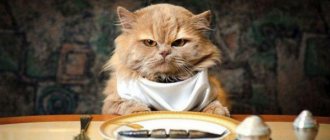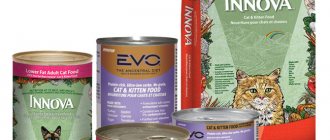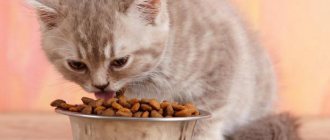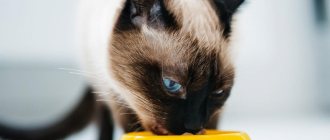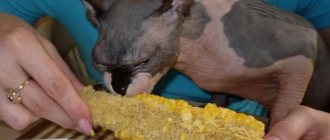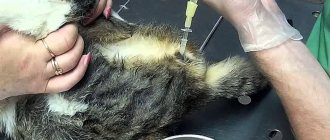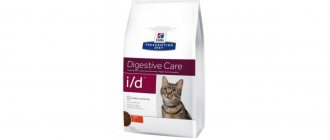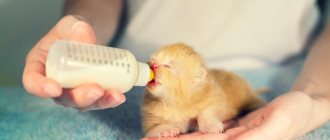Both veterinarians and the owners of these animals are still arguing about whether it is possible to feed a cat a mixed diet. This diet includes not only natural food, but also ready-made commercial feed. The main thing you should pay attention to when it comes to mixed cat nutrition is balance. The animal should receive equal amounts of proteins, fats and carbohydrates, as well as additional vitamins and beneficial microelements.
With this approach, of course, it is better to consult a veterinarian, and if the cat is purebred, get comprehensive information from an official breeder. The specifics of the functioning of the digestive system in different breeds also differ from each other, despite the fact that the cat is by nature a predator, and eating meat or fish is something that is inherent in nature. But overfeeding with meat does not always have a positive effect on the functioning of the stomach. The standard daily intake of meat ingredients should not exceed 20% of the total amount of food consumed.
Features of different types of food, pros and cons
Some cat owners believe that wet food contains more nutrients than dry food. Experts say that the composition of different products of the same brand is practically the same.
Dry ready-made food
Dry food from different manufacturers varies in composition. The quality of the product also depends on its class: economy, premium, super-premium and holistic.
Veterinarians do not recommend that cat owners purchase low-quality food that belongs to the economy class. This product contains very few natural ingredients and the animal does not benefit from it. Veterinarians recommend using premium or super-premium food as the main diet. Their composition is correctly balanced. These granules are made from quality products. They include fish, meat, vegetables, cereals, vitamins, macro- and microelements.
Holistic cats are usually purchased by breeders of pedigree cats who breed purebred animals for sale. High-quality dry food is also purchased for pets suffering from chronic diseases. Manufacturers of holistic products produce a variety of lines that take into account the needs of all categories of animals: kittens, adult and elderly pets, sick, castrated and sterilized.
The only drawback of dry granules is the low percentage of liquid content, so the animal needs constant unhindered access to fresh water. Among the advantages of high-quality dry food are:
- efficiency;
- possibility of long-term storage;
- nutritional value and presence of vitamins.
Wet (canned) food, pates and soufflés
The composition of wet food is identical to dry granules if they are produced by the same brand and belong to a single line. The difference between canned food and spiders from granules is the volume of liquid they contain. Wet types of products for cats contain about 70% moisture, dry types - no more than 7%.
Pets like canned food more than dry food. Cats are attracted to the delicious-smelling sauce or jelly, the consistency of the pieces and pates. This type of food is convenient to eat. However, veterinarians do not recommend feeding cats exclusively with it for a number of reasons:
- wet food does not provide long-term satiety, so animals constantly feel hungry and ask for additional portions, which leads to overeating and weight gain;
- soft food does not provide the necessary stress to the animal’s teeth and jaws, resulting in dental and gum disease;
- pieces are quickly digested in the stomach, which disrupts the digestive system of predators and can disrupt the functioning of the pancreas.
Natural products
Despite all the obvious advantages of natural food, it cannot be called absolutely healthy. To prepare quality food for your pet, you need more than just good ingredients. The owner must know what ratio of proteins, fats, carbohydrates, mineral components and vitamins the cat needs daily.
Dishes for the animal must be prepared taking into account the characteristics of the body. The food should contain boiled meat, fish or poultry, fermented milk products, and vegetables. When feeding your pets natural products, you must follow the following rules:
- Do not use raw meat and fish. Meat products that have not undergone heat treatment may be contaminated with parasites. Helminth larvae enter the animal's body with food and begin to multiply.
- Do not feed the same type of protein foods. Some owners prepare food for cats exclusively from fish. This diet negatively affects the condition of the liver and kidneys. Excess meat on the menu leads to a decrease in the amount of calcium in the body, and the animal’s bones become brittle.
- Do not feed undercooked or tubular bones. Cartilage, spongy bones, and chicken necks are rich in nutrients, but they must first be boiled well. Salmonella, E. coli and other pathogens can live in bones. Tubular bones often cause injuries to the mucous membrane of the gastrointestinal tract.
Vitamin supplements
Ready-made food is good because it already contains nutrients and vitamins in the required quantities and proportions. This is especially true for super premium and holistic foods. In this regard, there is no need to additionally introduce a multivitamin complex into the diet, except for health problems. And you shouldn’t do this without consulting a veterinarian.
Cat chooses food
It is worth taking vitamin supplements if the daily diet includes natural products , and the amount of prepared food consumed does not ensure the daily intake of nutrients into the body. As a rule, these are vitamins A, E, and group B. A lot of literature has been written about the benefits of each of them, so it makes no sense to focus on this information. In addition, these are not all vitamins that can be consumed to maintain the normal functioning of body systems.
Is it possible to give a cat dry and wet food at the same time?
Experts do not prohibit combining wet food with dry food, and in some cases, veterinarians even recommend this combination. If your cat is weakened, sick, or recovering from an illness, canned food will help you gain weight faster and regain a good appetite. To correctly combine pieces in sauce with granules, you need to adhere to the following rules:
- Do not offer your cat different types of food at the same time. It is better to alternate food at different meals, since a pet, having eaten one product, may refuse the second.
- Use products from the same manufacturer. This will allow you to maintain an optimal balance of nutrients from food.
- Place only one serving of food in a bowl. If you give your kitten a daily dose of dry food, he may eat it all and cause indigestion. Uneaten wet morsels will spoil, and the kibble will lose its odor and become unattractive to animals if it sits in the bowl all day.
- When introducing wet food, the portion size of dry kibble should be reduced. Recommendations for feeding different types of products from the same line are contained on the packaging.
"The Appetite of a Neutered Cat"
In modern conditions, at the age of one year, 93% of all cats have already undergone sterilization1, while 10% of all cats never go outside. This creates conditions for a sedentary lifestyle and, accordingly, increases the risk of gaining excess weight and developing diseases of the urinary system. In addition, most adult cats experience a gradual decline in their overall activity level. This is why it is very important that after sterilization, the daily amount of food is recalculated and changed based on recommendations for maintaining your pet's ideal weight. The attending veterinarian will tell you how to properly approach the issue of nutrition after sterilization.
Advice from Dr. Corinne Lauzen, Consulting Veterinarian for Perfect Fit - “After spaying, a cat may be prone to weight gain. Pet owners should not make the common mistake of increasing portion sizes due to weight gain, thinking that their cat is still growing.
One of the effective methods for controlling a cat's body weight is mixed feeding - a combination of dry food and, for example, 1 bag of wet food per day. Wet diets contain more water, meaning a larger portion of wet food contains the same number of calories as a regular portion of dry food, keeping your cat full and in good shape.
In addition, the combination of wet and dry food has other positive qualities: it helps maintain water balance and takes care of the health of the genitourinary system. It also makes the diet more varied and interesting, which your cat will certainly appreciate.
Dry and wet food - what's the difference?
Let's start with definitions. A balanced dry diet is a combination of many different ingredients mixed together and then dehydrated using a special technology. Balanced wet food is approximately the same combination of ingredients that have not been dried, but have been heat-treated and packaged in foil bags or cans, where they are stored without access to air until the package is opened.
As we see, in theory, the difference between these types of feed is only in the presence or absence of water. At the moment, there are no reliable studies that would show that one type of food is preferable to another or that mixing them in the same bowl or alternating them at different feedings can lead to any negative consequences for the body.
The same enzymes operate in the digestive system of animals, breaking down food ingredients into simple elements for their subsequent absorption in the intestines, regardless of the amount of water in their composition.
However, in practice, the difference between dry and wet food can be much greater than the level of humidity. Even if both dry and canned diets are balanced, that is, suitable for daily nutrition, where it is guaranteed that the combination of these two types of products will be balanced. There is no such certainty, because these diets may be very different in composition.
How to choose dry and wet food for mixed feeding?
In order for a mixed diet to be balanced, the compositions of wet and dry food must be as identical as possible, and finding such products is a rather difficult task.
For example, Acana or Orijen foods contain 75-85% meat ingredients, and if you replace part of their daily value with a wet diet, which contains much less meat, you are depleting your pet's diet of animal protein. Or, for example, there are no grains in biologically appropriate food, but they are found quite often in canned foods, and by including them in the diet, you essentially negate the benefits of a grain-free diet.
It’s even more difficult with macro- and microelements; their quantity and composition depend on the raw materials used, and therefore each manufacturer balances their feed differently. When we mix diets, there is a risk that there will be more of some substances than necessary, while others will be deficient.
Of course, you can make an effort to find canned foods that are close in composition to Acana and Orijen foods, and here are the distinguishing features that will help you do this:
- wet food should consist of meat ingredients with the addition of fiber sources in a volume of no more than 25–15%;
- all ingredients in wet food must be clearly named, indicating specific types of meat and their percentage;
- It is desirable that canned food contain several different sources of animal protein;
- a wet diet should not contain grains, vegetable proteins and various hydrolysates.
At the same time, we would like to warn you that Acana and Orijen foods are created according to strictly verified recipes, and the manufacturer guarantees that they fully meet the needs of dogs and cats. When you create a mixed diet yourself, you take responsibility for its balance.
The benefits of mixed food for cats
If we talk about the benefits of mixed nutrition, then, guided by the opinion of the majority, it is food that should be mixed: wet and dry, and not natural products with dry food. A variety of flavor combinations will allow your pet to try new tastes and always remain in a great mood.
The choice in favor of such a mixed diet is also due to the fact that the food already contains a balanced amount of substances necessary for the normal functioning of the body and overall well-being. And there is no need to add anything else. The main thing is to constantly monitor the availability of fresh drinking water: after all, when feeding dry food, drinking plenty of fluids is a prerequisite.
Recommended reading:
Review of Leonardo cat food: composition, types, reviews, price
How to feed dry and wet food?
There is no single recommendation on whether dry and wet food can be given in the same bowl or at different feedings. However, the second option is still preferable from the point of view of compliance with feeding standards. If your pet eats twice a day, then it is easy to divide the recommended daily dose of dry and wet food into two meals and give half of one in the morning and half of the other in the evening.
When you add a spoonful of wet food to dry food or vice versa, it is very difficult to calculate the norm. After all, dry food, due to its low moisture content, takes up much less volume and its norm, measured in grams, is much lower than that of wet food. It costs nothing to make a mistake, so we advise you not to create a mixed diet by eye, but to accurately determine the serving size and adhere to feeding standards for both diets.
Also in favor of separating these two types of foods into different meals is the possibility of individual reactions of the pet. When you give only one type of food at each feeding, then in case of digestive problems and other undesirable manifestations, you can accurately determine the “culprit”. Such situations arise especially often when owners change wet food, buying products of different brands or compositions, which we strongly do not recommend doing.
Is it possible to feed dry food and meat at the same time?
A meat diet is most suitable for cats, and dry mixtures do not always contain the required amount of meat ingredients. Many owners of furry animals try to supplement their pets' diet with meat, fearing that the animal is not getting enough nutrients.
Premium industrial mixtures are perfectly balanced and contain all the nutrients necessary for a cat’s body. It is allowed to allow your pet some meat (boiled, frozen) as a treat, but introducing meat products into daily feeding is irrational.
The share of treats should be no more than ten percent of the daily portion. It is recommended to serve meat a few hours after eating.
Be sure to read:
Development of kittens by weeks and months: how they grow, look, until what age is considered a kitten
It is forbidden to mix dry mixture and raw meat. Heat-treated mixtures are digested faster than raw meat, resulting in vomiting, discomfort, and digestive problems in the cat.
Is it necessary?
We don't know why you decided to mix dry and wet food because, except for special physiological conditions where wet food is recommended, there is no reason to stick to this type of feeding. On the contrary, it causes some difficulties and risks associated with an insufficiently balanced diet, receiving excess or insufficient amounts of nutrients.
At the same time, feeding one dry food, provided the selected diet is of high quality, allows you to reduce them to a minimum. In any case, we respect your choice and hope that with our advice we have helped you establish mixed feeding without harm to your pet.
The difference between wet food and dry food
Wet cat food seems to be a convenient choice for owners: it is readily eaten by cats, well-balanced and healthy.
Liquid cat food with a high meat content is an excellent option either as a base or as a supplement. If the cat does not like dry food, then mixing it with wet food is quite possible. The main benefit of wet food is that it contains water, which is an important component in keeping your cat healthy. This is especially important in the summer, as well as for pets with kidney or bladder problems.
Eating a balanced diet for your pet is important for its health.
Important! The basis for good health and well-being of a pet is a properly selected diet.
Wet food has many benefits for both cats and their owners. Among them:
- a large amount of protein and fats, which are necessary for the health of the pet;
- low percentage of carbohydrates, which does not contribute to excess weight gain;
- the composition includes water (75%), which is beneficial for the pet, especially for those who drink little liquid. Moisture in food prevents gastrointestinal problems;
- ability to quickly saturate a cat due to its high protein content. The animal is not prone to overeating;
- ease of use: open it, put it in a bowl and you're done.
Among the most significant disadvantages of wet food are:
- is not able to protect your pet from the formation of tartar and gum disease. When using only this type of food, it is necessary to separately take care of your pet’s teeth with other means;
- Storage of open packages lasts a short time. Opened canned food only lasts for a couple of days even in the refrigerator;
- more expensive than regular dry.
Wet food is convenient for owners
Wet cat food comes in many forms. It differs both in packaging and consistency. In pet stores you can find products packaged in jars or bags. The former have different capacities: small cans (70–100 g) to large sizes and more economical options (200–400 g). The packages have a small volume, from 85 to 100 g.
The consistency of wet food is much more varied than the dry version. In jars you can find carefully chopped pieces of meat or fish. Another type is reminiscent of canned food. You can find jars and bags of whole pieces of meat in sauce or jelly.
Important! The best option for wet food is in the form of pate. It is soft and easy to serve the animal.
Canned food is the most popular wet type of food for cats. In this case, pieces of meat or fish are visible and the quality of the food can be assessed at first glance. Their composition can contain up to 90% meat.
Dry food has a number of advantages:
- saving money. It is financially more profitable to purchase dry food in large packages;
- saving the owner's time. Simply pouring a handful of food into a bowl is enough;
- with good quality, you do not need to follow a diet;
- quality food is well balanced and rich in nutrients. It is worth choosing a trusted manufacturer.
Disadvantages of dry options:
- little moisture leads to problems with the urinary system, especially if the animal consumes little water;
- harms cats' teeth, contrary to the existing myth that dry food cleans teeth;
- if the quality of the food is low, it contains a lot of carbohydrates, which can cause a jump in blood sugar and lead to an imbalance in metabolic processes;
- cats getting used to low-quality dry food options due to aromatic additives.
Dry food has its advantages and disadvantages
Ten myths about cat nutrition
food ALL ARTICLES 42693
Photo: Laszlo Ilyes /
We present to your attention and discussion an article by American holistic veterinarian Dr. Jean, in which she examines 10 common myths about cat nutrition and offers a look at the facts behind these myths:
Myth No. 1. The best foods are those recommended by veterinarians (Royal Canin, Purina, Hills, etc.).
Despite the fact that such foods are positioned on the market as “premium” or “top” in their class, one look at their composition tells a completely different story. Their formulas contain protein derived mostly from grains or by-products of corn, brewer's rice and wheat, rather than meat.
Such feeds often contain so-called “poultry by-products,” consisting of waste from the food industry - legs, heads, undeveloped eggs and intestines - anything but meat. Protein from such cheap, low-quality sources is much more difficult to digest than from natural chicken meat. The presence of such ingredients in food is a signal that clearly indicates their low quality, like the cheapest brands. When choosing a good food, make sure that the ingredient list lists meat, meat meal or poultry meal BEFORE the grains. The high content of grains in cat food is the main cause of obesity and allergies (although not all grains are so bad for cats, see Myth No. 7). And to understand how to “decipher” the composition of the food printed on the packaging, read this article.
Myth No. 2. Dry food helps clean teeth.
Photo: Simon Law /
This opinion can sometimes be heard even from veterinarians, but it does not correspond to reality. Cats have very sharp teeth, even the molars - not flat, like ours, but pointed. These teeth are designed to bite, tear and chew raw meat, and when a cat eats kibble, it either swallows it whole or crushes it into crumbs. Dry food granules do not clean the teeth in any way in the places where the gums are adjacent to them - and this is where dental problems usually begin. Moreover, dry food can cause problems: its crumbs, getting stuck between the teeth, contribute to the growth of bacteria. Just like in humans, the remains of carbohydrate foods in the mouth turn into sugar - a breeding ground for bacteria. So dry food is no help for clean teeth. The key to healthy teeth is natural food and regular brushing.
Myth No. 3. Cats need an age-appropriate diet: kitten, adult, senior.
Photo: MrkJohn/
Age-related diets were invented only for marketing: the more assortment a manufacturer has, the more space it takes up on store shelves. Of course, kittens - in proportion to their weight - need more food than adult cats, but this does not mean that they need any special diet. All they need is a varied diet of good quality. Dry food should not be the basis of a kitten's diet - it provokes dehydration and urinary problems, which over time can lead to other diseases. Cats are carnivores, which means they need a lot of meat and very few carbohydrates. Natural meat and grain-free products are a good addition to dry food, but it is even better to feed kittens with canned food, supplementing them with freeze-dried, dehydrated and raw foods.
During the active growth phase, kittens need to be fed more often - three times a day. And when they reach three to four months, you can reduce the number of meals to two times. Kittens—and adult cats—should remain fit; Watch your pet's waist and do not let it become round.
Older pets become less active as they age and need fewer calories, but the need for healthy food is greater than ever. As they age, they need more healthy resources to keep their immune system and joints functioning at their best. Let them eat less, but the food should remain high quality and varied. Older cats are especially susceptible to diseases caused by obesity - diabetes, arthritis, and diseases of the genitourinary system.
Myth No. 4. Our table scraps and other human food are definitely harmful to cats.
Photo: Finn Frode /
Most "holistic" veterinarians encourage the practice of feeding animals "human" food. They believe that “healthy” scraps can be a good addition to a cat’s regular diet. You just need to follow two immutable rules: - “healthy” scraps are what is healthy for cats (steamed meat, finely chopped vegetables and fruits, baked sweet potatoes, rice, oatmeal); — food “from the table” should not form the basis of the cat’s diet, but if you feed it what you eat yourself, then make sure that the cat does not overeat.
It is important to remember that foods that are good for people can be very harmful for cats. For example, onions, grapes or raisins are poison for them. If you are not sure about the safety of the product, do not give it to your cat!
In recent years, the fashion for feeding cats home-cooked food has returned. Ready-made mixtures and semi-finished products from healthy vegetables and grains, which are used as a “side dish” for natural meat, are popular on the American market.
Myth No. 5. Cats should be fed only “complete” or “balanced” food.
Photo: Michael Frank Franz /
Feed manufacturers have a vested interest in perpetuating this myth. Think: can each of your lunch or dinner be called “comprehensive” and “balanced”? Even those of us who are morbidly concerned about our health do not make sure that each dish has the “right” balance of nutrients. We understand that our diet throughout the day or week will ultimately be fairly balanced. And many of us take vitamins and nutritional supplements because even the healthiest and most natural diet cannot provide our body with all the vitamins and minerals it needs.
It's the same with cats: variety is the key to a healthy diet. If you feed your cat industrial “complex” and “balanced” food, that’s good, but let it make up no more than 50–60% of his diet. Canned meats, raw and cooked meats, suitable human food, fresh vegetables will all add to the nutritional value of your cat's diet. Taking a daily multivitamin won't hurt either. Just remember one thing: meat contains more phosphorus than calcium, so if natural meat makes up more than 15 - 20% of your cat's regular diet, she will need to be given a calcium supplement to maintain the correct balance.
Myth No. 6. Raw food is a potential source of salmonella and E. coli.
Photo: Andrey /
The digestive tract of cats is very different from that of humans. The length of our intestines is 7 - 8 meters, and the acidity of the stomach is low - from 1.5 to 2 PH (PH is an indicator of an alkaline environment). In cats, the length of the intestine does not exceed 3 meters, and the acidity of the stomach is higher - less than 1 PH. This means that raw food passes through your cat's digestive tract twice as fast, and the high acidity of its stomach kills most bacteria. Even if the food has been contaminated, it is highly likely that microbes will not be able to get from it into the animal’s blood. Large official suppliers of raw meat carefully monitor their products and take measures to prevent unwanted microorganisms from entering them. But if you still doubt the origin of the meat, then place it in the freezer for two or three days: salmonella and E. coli do not survive freezing.
Otherwise, when feeding your cat raw meat, you need to observe basic hygiene requirements: defrost frozen meat in the refrigerator; wash dishes and bowls after each meal preparation and feeding; Do not leave raw food in the bowl for longer than 30–40 minutes (and immediately throw away any leftovers that have been left over for this period). From a common sense point of view, feeding cats raw food is not much more difficult or dangerous than prepared food, and the health benefits are incomparable.
Myth No. 7. High protein levels are detrimental to health, especially in older cats.
Pattern: Only Natural Pet
The origins of this myth are the use of low quality feed. The truth is that only plant proteins are dangerous - their excess can harm the cat's health. While a high content of animal proteins is not only beneficial, but also necessary, especially for aging cats. Bad mass-produced foods are literally chock full of plant proteins derived from soy and corn. Unfortunately, the cat simply is not able to properly digest and absorb them - its digestive system is not designed to process such ingredients. When choosing ready-made food for your cat, make sure that corn or soy are not high on the list of ingredients. And it’s even better that they don’t exist at all. The main source of protein for your animal - even in dry and canned food - should be meat (chicken, lamb, beef, fish).
Myth No. 8. Ash content is an important parameter when choosing feed.
Photo: Bryan/
Veterinarians and cat breeders have begun to pay attention to the ash content in cat food in search of the causes of urinary tract diseases. In the 1970s and 80s, veterinarians believed that ash caused crystals in urine. Today, several factors are known that cause diseases, and ash is no longer one of them. The main reason is the formula for mass production of dry food. The biggest and worst part is that some of these foods contain too many grain ingredients, which increase the alkaline environment in the urine, which leads to the formation of biological crystals. While a more natural meat diet for cats contributes to increased urine acidity.
A diet high in animal protein is the best way to maintain low urine pH. In general, cats that eat canned food are less susceptible to genitourinary diseases than cats that eat dry food. This is due to the fact that canned food tends to contain more meat and moisture. Eating frozen raw food is generally ideal for maintaining healthy PH levels and preventing dehydration. The passion for “low-ash” food does not solve the problem of urinary tract diseases, but a healthy diet and high-quality food does.
An even more effective way to prevent diseases is to take care of your cat’s emotional state. Stress and lack of physical activity are important factors provoking diseases of the genitourinary system. When a cat is stressed, its immune system weakens. Moreover, when you are stressed, your cat is most likely in shock too. Special flower essences for cats help combat stress. In the West, a variety of flower essences are produced that are designed to relieve various emotional disorders or problems. Choosing one or two essences - depending on the problems of a particular cat - owners simply add them drop by drop to a bowl of water or rub them into her paws and ears.
Myth No. 9. Changing the brand of food is stressful for your cat’s digestion.
Photo: Anna Dragatsika /
A healthy cat, like a healthy person, can eat a variety of foods at each meal—as long as it's healthy food, of course. Variety is important for a number of reasons, most notably because it helps avoid developing unhealthy sensitivities or allergies to a particular food or type of protein. When a cat eats the same food for months or years, it may develop an allergy or sensitivity to one of the ingredients. Sometimes feeding the same food for a long time leads to upset and inflammatory bowel disease. A varied diet satisfies the cat's needs much better - after all, you would hardly agree to eat the same thing every day.
No matter what you feed your cat, he can benefit from the right supplements. For example, veterinary digestive enzymes will help your cat switch from one food to another without any problems. These supplements help keep the digestive tract in good shape and promote efficient breakdown of food. Essential fatty acids, especially fish oil, provide your cat with the omega-3 fatty acids lost in highly processed ingredients in dry and canned foods. Fatty acids nourish the cat's skin and fur and stabilize the gastrointestinal tract. Dietary supplements – probiotics – can help solve problems with gastrointestinal disorders.
Myth No. 10. It’s okay if cats and dogs “steal” food from each other.
Photo: snuzzy /
It is no coincidence that most dry and canned foods are developed specifically for cats or dogs. Cats require more protein and fat, and sufficient taurine is important for them. Dogs who are addicted to “raiding” on cat bowls run the risk of developing obesity and even pancreatitis. Cats who "inspect" dog food are at risk of becoming overweight because dog food contains much more carbohydrates. Even after gorging itself on dog food, the cat remains deprived of vital amino acids, primarily taurine.
Source: Only Natural Pet
health, food
Comments ()
- Olga Mikhailova November 24, 2021, 15:57 0
I agree with everything, except for the harmful advice to give some random vitamins and nonsense about the need for a varied diet.- Mikhail Galich January 07, 2021, 15:21 0
Olga, I cannot agree. Multivitamin supplements are not exactly “some random vitamins”, and, judging by the text, they are recommended to be given to cats that are fed monotonous industrial food. A varied diet doesn't hurt either. For example, why not feed astronauts only biscuits, stuffed with proteins, carbohydrates and vitamins?))) The advice that industrial food should make up no more than 60% of a cat’s diet seems quite reasonable to me.
Log in to leave a comment
Use your social network account:
GoogleFacebookVkontakteMailruYandex
Is it possible to feed a cat both dry and wet food?
As a rule, the healthiest option is still natural food, which includes a balanced and suitable diet for the cat. When there is absolutely no time to cook, the question arises whether it is possible to combine dry food and natural food for cats. Answer: it is possible, but the quality of dry (wet) food must be high. It is necessary to purchase premium and holistic food.
Although it is possible to mix dry and wet food together, this is not recommended as the cat's digestive system gets used to a certain type of food, releasing the corresponding enzymes. And when mixing different options, he may have problems with the gastrointestinal tract. However, mixed meals at home are acceptable, but not often and at different meals. In this case, it is better to combine food from the same manufacturer.
Mixing food is possible, but it should be done wisely
Is it possible to mix different manufacturers?
Those who believe that it is possible to mix cat food from different manufacturers are mistaken. The reasons for this are:
- different balance;
- different calorie content.
Each manufacturer achieves feed balance in its own way, which is reflected in their composition. The same level of protein is obtained from both low-quality plant elements and high-quality animal raw materials.
By mixing food, it is impossible to improve the quality of food that is inferior in composition. In such a situation, even the best food will not be beneficial. There will be an imbalance that every manufacturer strives for in order for the product to be considered a complete nutrition. It turns out that there will be more of some substances, less of others, which is fraught with the appearance of various diseases for the animal.
When do you need to change the type or diet of feeding?
Restrictions:
- It is prohibited to introduce dry food and homemade food into your pet’s diet.
- You cannot feed raw and boiled foods at the same time.
It should be noted that premium industrial food contains a sufficient amount of useful substances: necessary for the full development of a small predator. Adding natural food to the diet can cause disruption in the animal’s body.
The combined use of two types of products is allowed only when changing the diet.
A change in diet is necessary if:
- the animal ages, matures;
- the pet has been diagnosed with a chronic disease;
- castration or sterilization surgery awaits;
- food allergy detected.
The change in diet should be gradual, new food should be introduced in small portions, gradually completely removing the previous food from the diet. The cat is transferred to a new diet within 20-25 days.
It is forbidden to treat your cat with pieces “from the table”. Food is given out in several stages. One stage is natural food, the second stage is dry pads, the share of new food increases every day. Food bowls should be removed as soon as the animal has eaten.
Feeding standards
All packages of ready-made food indicate the dosage of the daily portion in grams, depending on the age and weight of the animal.
The amount of wet food is considered normal at a value of 5% of the animal’s weight. That is, if a pet weighs 5 kg, then 175 g of wet food per day is enough for him.
Note! A cat with a calm lifestyle needs 70 ml of water per 1 kg of weight per day, and with an active lifestyle - 85 ml per 1 kg of weight. This is approximately 4-6 tbsp. spoons of water.
For adult cats, the daily intake of dry food is:
- weight up to 3 kg - 25 g;
- weight from 3 to 4 kg - 40 g;
- weight from 4 to 5 kg - 55 g;
- weight over 5 kg - 12 g per 1 kg of weight.
For a kitten this norm looks like this:
- weight up to 2 kg - 35 g;
- weight from 2 to 3 kg - 50 g;
- weight from 3 to 4 kg - 70 g.
A pregnant cat needs 55 g of dry food per day.
For large breed cats, the calculation is based on the rule: 12 g per 1 kg of animal weight.
For older animals, the norm is slightly reduced by 10-20%.
For active cats, the feeding schedule is free in large portions.
For sterilized cats, food is given 2 times a day in small portions, as they are prone to obesity.
Feeding standards for cats should be followed
What does a cat eat
A cat is an animal that receives all the nutrients in nature from one food source. Depending on their habitat, wild cats mainly catch small rodents, birds and sometimes have the opportunity to catch fish. They do not decorate their lunch with a scattering of steamed vegetables and do not fill the meat with a tasty side dish. Nature has provided another chain: potential prey consumes cereals, fruits and vegetables, and then the cat receives a ready-made stuffed dish.
Domestic cats are not much different from wild cats in terms of nutrition. But selection and the emphasis on breeding beautiful individuals have made them vulnerable and capricious in matters of food. A rare cat can be persuaded to eat a balanced porridge of meat, cereals and vegetables, strictly observing the boundaries of the norm. As a rule, taste preferences take over and some of what is offered is eaten, which makes such food not particularly healthy.
In one bowl or separately
There is no single recommendation on this matter from veterinarians and well-known manufacturers. Some believe that it is possible to mix different types of food in one bowl. Others insist that time should pass between the intake of dry and wet food. Since no research has been conducted on this issue, there is no clear answer.
Most recommendations highlight the following points:
- separation of food makes it possible to accurately track how much and what was given to the pet in terms of volume, composition, how much the animal eats, what can be mixed and what cannot;
- if you alternate food, it is easier to track the animal’s reaction to one or another type of food: what caused the allergy, indigestion and other undesirable effects;
- mixing feed leads to spoilage of the dish and loss of taste characteristics much faster.
Important! It is worth trying a mixed feeding option first, then separate feeding. You need to track which option was more preferable for the cat and make a choice in its favor.
Time to keep food in bowl
For wet food, opened packaging should be kept in the refrigerator for no more than 2-3 days. In this case, the food should be transferred to a glass bowl.
It is advisable to store the opened food packaging in the refrigerator, hermetically sealed. Air access contributes to the oxidation of components and loss of their value.
Important! If wet food is in your cat's bowl, you should not leave it all day: it may spoil or dry out, especially if the room is hot.
The shelf life of dry food is usually indicated on the packaging. But it concerns exclusively the hermetically sealed version. However, an open pack of dry food can only be stored for 1.5-2 months. The fact is that the fats in the food are oxidized, which can cause gastrointestinal upset in the pet.
It is better not to leave food in a bowl for a long time

